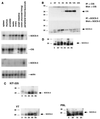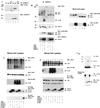SOCS-3 is tyrosine phosphorylated in response to interleukin-2 and suppresses STAT5 phosphorylation and lymphocyte proliferation
- PMID: 10373548
- PMCID: PMC84319
- DOI: 10.1128/MCB.19.7.4980
SOCS-3 is tyrosine phosphorylated in response to interleukin-2 and suppresses STAT5 phosphorylation and lymphocyte proliferation
Abstract
Members of the recently discovered SOCS/CIS/SSI family have been proposed as regulators of cytokine signaling, and while targets and mechanisms have been suggested for some family members, the precise role of these proteins remains to be defined. To date no SOCS proteins have been specifically implicated in interleukin-2 (IL-2) signaling in T cells. Here we report SOCS-3 expression in response to IL-2 in both T-cell lines and human peripheral blood lymphocytes. SOCS-3 protein was detectable as early as 30 min following IL-2 stimulation, while CIS was seen only at low levels after 2 h. Unlike CIS, SOCS-3 was rapidly tyrosine phosphorylated in response to IL-2. Tyrosine phosphorylation of SOCS-3 was observed upon coexpression with Jak1 and Jak2 but only weakly with Jak3. In these experiments, SOCS-3 associated with Jak1 and inhibited Jak1 phosphorylation, and this inhibition was markedly enhanced by the presence of IL-2 receptor beta chain (IL-2Rbeta). Moreover, following IL-2 stimulation of T cells, SOCS-3 was able to interact with the IL-2 receptor complex, and in particular tyrosine phosphorylated Jak1 and IL-2Rbeta. Additionally, in lymphocytes expressing SOCS-3 but not CIS, IL-2-induced tyrosine phosphorylation of STAT5b was markedly reduced, while there was only a weak effect on IL-3-mediated STAT5b tyrosine phosphorylation. Finally, proliferation induced by both IL-2- and IL-3 was significantly inhibited in the presence of SOCS-3. The findings suggest that when SOCS-3 is rapidly induced by IL-2 in T cells, it acts to inhibit IL-2 responses in a classical negative feedback loop.
Figures





Similar articles
-
Interleukin 9 induces expression of three cytokine signal inhibitors: cytokine-inducible SH2-containing protein, suppressor of cytokine signalling (SOCS)-2 and SOCS-3, but only SOCS-3 overexpression suppresses interleukin 9 signalling.Biochem J. 2001 Jan 1;353(Pt 1):109-116. Biochem J. 2001. PMID: 11115404 Free PMC article.
-
SOCS/CIS protein inhibition of growth hormone-stimulated STAT5 signaling by multiple mechanisms.J Biol Chem. 1999 Dec 10;274(50):35553-61. doi: 10.1074/jbc.274.50.35553. J Biol Chem. 1999. PMID: 10585430
-
Tyrosine-phosphorylated SOCS-3 inhibits STAT activation but binds to p120 RasGAP and activates Ras.Nat Cell Biol. 2001 May;3(5):460-5. doi: 10.1038/35074525. Nat Cell Biol. 2001. PMID: 11331873
-
The role of Stat5a and Stat5b in signaling by IL-2 family cytokines.Oncogene. 2000 May 15;19(21):2566-76. doi: 10.1038/sj.onc.1203523. Oncogene. 2000. PMID: 10851055 Review.
-
Cytokines: shared receptors, distinct functions.Curr Biol. 1997 Jul 1;7(7):R424-6. doi: 10.1016/s0960-9822(06)00208-9. Curr Biol. 1997. PMID: 9210372 Review.
Cited by
-
Specific Jak3 Downregulation in Lymphocytes Impairs γc Cytokine Signal Transduction and Alleviates Antigen-driven Inflammation In Vivo.Mol Ther Nucleic Acids. 2012 Sep 4;1(9):e42. doi: 10.1038/mtna.2012.37. Mol Ther Nucleic Acids. 2012. PMID: 23344234 Free PMC article.
-
Suppression of inflammatory gene expression in T cells by Porphyromonas gingivalis is mediated by targeting MAPK signaling.Cell Mol Immunol. 2013 Sep;10(5):413-22. doi: 10.1038/cmi.2013.23. Epub 2013 Jul 29. Cell Mol Immunol. 2013. PMID: 23892429 Free PMC article.
-
Zfp36l1 establishes the high-affinity CD8 T-cell response by directly linking TCR affinity to cytokine sensing.Eur J Immunol. 2024 Feb;54(2):e2350700. doi: 10.1002/eji.202350700. Epub 2023 Dec 7. Eur J Immunol. 2024. PMID: 38039407 Free PMC article.
-
Inhibitory roles for SHP-1 and SOCS-3 following pituitary proopiomelanocortin induction by leukemia inhibitory factor.J Clin Invest. 1999 Nov;104(9):1277-85. doi: 10.1172/JCI7924. J Clin Invest. 1999. PMID: 10545526 Free PMC article.
-
Leptin signal transduction in the HP75 human pituitary cell line.Pituitary. 2000 Dec;3(4):211-20. doi: 10.1023/a:1012994712851. Pituitary. 2000. PMID: 11788008
References
-
- Adams T E, Hansen J A, Starr R, Nicola N A, Hilton D J, Billestrup N. Growth hormone preferentially induces the rapid, transient expression of SOCS-3, a novel inhibitor of cytokine receptor signaling. J Biol Chem. 1998;273:1285–1287. - PubMed
-
- Auernhammer C J, Chesnokova V, Bousquet C, Melmed S. Pituitary corticotroph SOCS-3: novel intracellular regulation of leukemia-inhibitory factor-mediated proopiomelanocortin gene expression and adrenocorticotropin secretion. Mol Endocrinol. 1998;12:954–961. - PubMed
-
- Bjorbaek C, Elmquist J K, Frantz J D, Shoelson S E, Flier J S. Identification of SOCS-3 as a potential mediator of central leptin resistance. Mol Cell. 1998;1:619–625. - PubMed
-
- Callus B A, Mathey-Prevot B. Interleukin-3-induced activation of the JAK/STAT pathway is prolonged by proteasome inhibitors. Blood. 1998;91:3182–3192. - PubMed
Publication types
MeSH terms
Substances
LinkOut - more resources
Full Text Sources
Other Literature Sources
Research Materials
Miscellaneous
